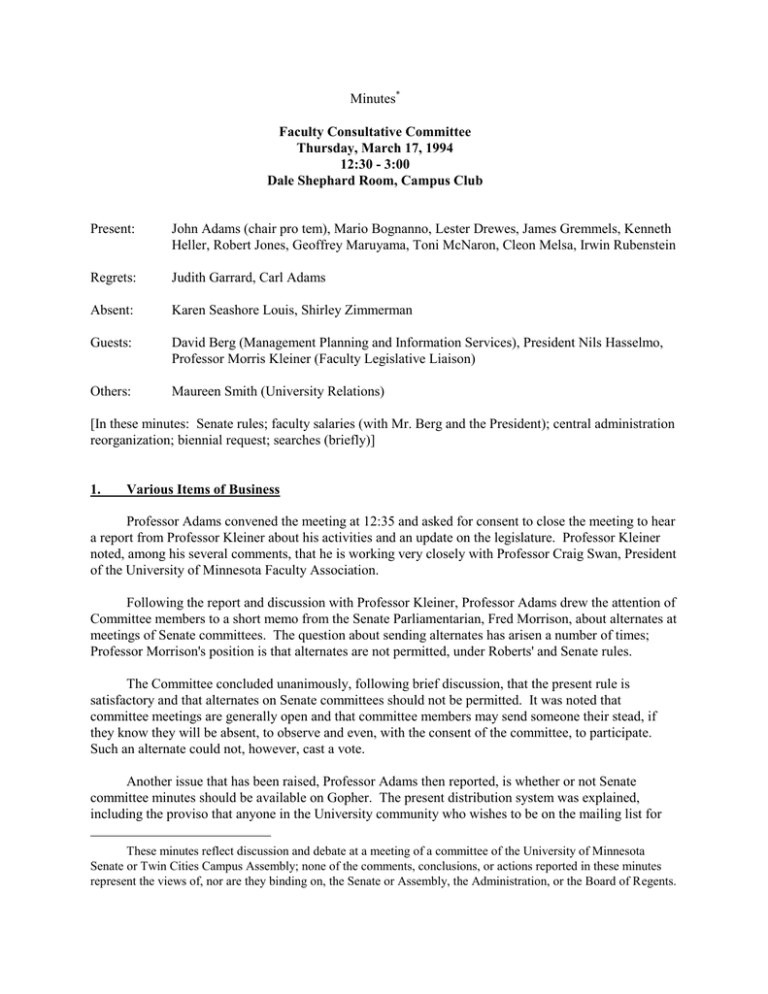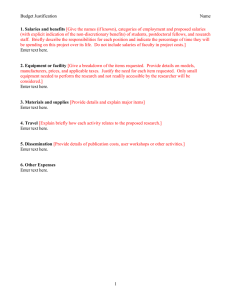Minutes Present: John Adams (chair pro tem), Mario Bognanno, Lester Drewes, James...
advertisement

Minutes* Faculty Consultative Committee Thursday, March 17, 1994 12:30 - 3:00 Dale Shephard Room, Campus Club Present: John Adams (chair pro tem), Mario Bognanno, Lester Drewes, James Gremmels, Kenneth Heller, Robert Jones, Geoffrey Maruyama, Toni McNaron, Cleon Melsa, Irwin Rubenstein Regrets: Judith Garrard, Carl Adams Absent: Karen Seashore Louis, Shirley Zimmerman Guests: David Berg (Management Planning and Information Services), President Nils Hasselmo, Professor Morris Kleiner (Faculty Legislative Liaison) Others: Maureen Smith (University Relations) [In these minutes: Senate rules; faculty salaries (with Mr. Berg and the President); central administration reorganization; biennial request; searches (briefly)] 1. Various Items of Business Professor Adams convened the meeting at 12:35 and asked for consent to close the meeting to hear a report from Professor Kleiner about his activities and an update on the legislature. Professor Kleiner noted, among his several comments, that he is working very closely with Professor Craig Swan, President of the University of Minnesota Faculty Association. Following the report and discussion with Professor Kleiner, Professor Adams drew the attention of Committee members to a short memo from the Senate Parliamentarian, Fred Morrison, about alternates at meetings of Senate committees. The question about sending alternates has arisen a number of times; Professor Morrison's position is that alternates are not permitted, under Roberts' and Senate rules. The Committee concluded unanimously, following brief discussion, that the present rule is satisfactory and that alternates on Senate committees should not be permitted. It was noted that committee meetings are generally open and that committee members may send someone their stead, if they know they will be absent, to observe and even, with the consent of the committee, to participate. Such an alternate could not, however, cast a vote. Another issue that has been raised, Professor Adams then reported, is whether or not Senate committee minutes should be available on Gopher. The present distribution system was explained, including the proviso that anyone in the University community who wishes to be on the mailing list for These minutes reflect discussion and debate at a meeting of a committee of the University of Minnesota Senate or Twin Cities Campus Assembly; none of the comments, conclusions, or actions reported in these minutes represent the views of, nor are they binding on, the Senate or Assembly, the Administration, or the Board of Regents. Faculty Consultative Committee March 17, 1994 2 the minutes, by paper or email, need only request them. There was no sentiment for putting the minutes on Gopher. Professor Adams then introduced Professor Cleon Melsa from the Crookston campus, who has been elected to replace Professor Harvey Peterson for Spring Quarter, who is on leave. The Committee welcomed Professor Melsa. 2. Faculty Salaries (Earlier in the meeting, there had been a short discussion of the contract negotiated by the faculty in the State University System; it provides for salaries of $68,000 for professors with 20 years of experience, for $71,000 with 21 years of experience, $75,000 with 22 years of experience, and so on. There is, in addition, an add-on for faculty with Ph.D.s of up to 10%; there is also overload pay. It appears that the comparable mean for University professors (assuming 20 years of experience) is about $66,000. These data provoked considerable consternation among Committee members.) Professor Adams then turned to Professor Bognanno for a report on the Compensation Working Group and the issues it is addressing. Professor Bognanno explained the activities of the Working Group. -- It has two jobs, first to define its mission (which it will do within the month) and second, to address the problem. -- The problem has two parts: a larger issue that must be addressed in a simple, credible, professional way, and a series of smaller issues. -- The bigger problem is: (1) to define and justify criteria for who should be in the University's comparison group, for salary purposes; (2) once those criteria have been identified, performance information will be collected about the comparison group (reputational scores, research funding, etc.); (3) once the variables have been controlled for, it must be shown that compensation drives performance. The link between performance and compensation MUST be demonstrated when the University raises the issue of salaries, and must ultimately be linked to U2000. Once pay and performance have been considered, then the President and Board of Regents must be asked what kind of university they want. Benchmarks and long-term objectives can be identified. This will provide the University a measure it has not had before to make the arguments crisply, coherently, and credibly. -- The series of smaller issues the Working Group will take up include administrator augmentation for faculty who take administrative positions, a way to link increments in salaries, by unit, to faculty performance in areas such as teaching and service, and how to balance the need to respond to the market to deal with competitive offers with the need to reward individuals who are contributing scholars and participants in a department but who have not gone on the market. Faculty Consultative Committee March 17, 1994 3 Professor Adams next called on Mr. Berg to review for the Committee the information he presented to the Board of Regents on faculty salaries. Mr. Berg began by telling the Committee he has come upon a notion that he has not seen any exposition of in the literature but that he believes deserves exposure. MPIS did a study last year of tuition rate increases, for the legislative auditor. The study found that tuition tracked inflation through about 1981; after that it increased dramatically faster than inflation. The causes of the increase can be attributed to several factors (inflation itself, fewer students to bear the tuition burden, a decline in state support, and increased spending per student). The study found that 85-90% of the increase beyond inflation was directly attributable to the decline in state support--the vast majority of the large increase in tuition was used to make up for the loss of state funding. The legislative auditor adopted the study's methods for analysis of the other systems of higher education and found the same result. There are now data on tuition which suggest the phenomenon is generalizable to the entire nation. The public institutions evidently used tuition increases to replace lost public funds, which provided private institutions with an opportunity to increase tuition without harming their relative position in the market. They used the increased tuition income largely for faculty salaries since they did not have to replace any lost funding. Mr. Berg then turned to the slides he had used in the presentation to the Board of Regents. A first question was whether or not faculty salaries have kept up with inflation. Taking 1974 as the base year, by 1982 salaries had dipped to 82% of the base, they reached 96% of the base in 1991, and have now dropped back to 92.5% of the base year. There have been significant differences among professorial terms and rank in impact; 9-month assistant professors have slipped only 1% below the base year while 12-month associate professors have slipped 10% and 12-month assistant professors have slipped 20%. In terms of comparison with Big Ten public institutions (excluding Penn State), the University has slipped slightly, both in cash salary and in total compensation. This is not a big deal, Mr. Berg commented, and is unlikely to cause legislative concern. What they might listen to is the fact that IOWA has passed Minnesota by. None of the salary figures take into account cost of living, Mr. Berg told the Committee in response to a query. An outstanding study done at Michigan State demonstrated that cost of living does not vary enough to make any difference in salary comparisons (with the possible exception of extreme cases, such as New York City). It is better to leave cost of living out because it contributes almost nothing to the studies. In terms of comparison with the most prestigious research universities, the University (ranked 16th in quality in a 1983 CHANGE magazine article, the best standard available now); its compensation, all ranks combined, is now 25th of the top 30 reporting institutions. It is 9th of 13 among the publics in that same group. Full professor salaries are 30th of 30. Faculty Consultative Committee March 17, 1994 4 To what extent has the University kept up with national competition? Is the competition changing? Mr. Berg said that for the period 1973-1993, the University's faculty salaries tracked public doctoral institution salaries quite closely, varying between the average and 5% above the average (and some of the institutions in this group are not major research universities). (All figures are for 9-month professors, although the data likely reflect the entire market.) During that same period, salaries at private doctoral institutions have increased much more rapidly. In 1973, private salaries were about 1.9% above the University's salaries (4.7% above the publics); in 1993 they are 21% above the University's salaries (27% above the publics). The private doctoral institution salaries began to increase dramatically about 1981-82; the cash salary for 9-month professors at private institutions is now over $80,000. If one considers again the tuition study, it is clear what has happened. As states cut support, public institutions raised tuition to make up the lost funding. That gave the private institutions license to raise tuition as well, the additional income from which was funneled into faculty salaries. Mr. Berg emphasized and underscored his conclusion from these data: If the legislatures continue to not provide funding for universities, and populist legislature and regents continue to hold down tuition, THERE WILL SOON BE TWO HIGHER EDUCATION SYSTEMS IN THIS COUNTRY, ONE THAT PAYS WELL AND ATTRACTS THE BEST FACULTY AND ONE THAT DOES NOT PAY WELL, DOES NOT ATTRACT THE BEST FACULTY, BUT THAT HAS LOW TUITION. THE SYSTEM WITH THE BEST FACULTY WILL BE PRIVATE, THE ONE WITH LESSER QUALITY FACULTY WILL BE PUBLIC. It is, Mr. Berg also concluded, crazy for the University to continue to compare its salaries only with public institutions. One response one gets from legislators when the University is said to rank 30th of 30 in top research university salaries, said one Committee member, is that the University should raise its salaries-the legislature does not set salaries. And non-resident students at Michigan, for example, pay $16,000 per year. What should be said vis-a-vis Michigan, Mr. Berg pointed out, is that if the legislature and Regents will permit the University to raise tuition by 50% for resident students, Minnesota could be like Michigan. The University does not do so because the populist legislature intensely dislikes posted tuition rates that high. The argument, now, may be with the Board of Regents, it was said. They are not facing the facts, and since there is no one available to do the loaves and fishes routine, if state funding is not increased, if tuition is not increased, salaries will not be competitive, and something will give. Quality, pointed out another Committee member. It won't be programs, said another; the legislature won't allow that; there was an enormous hue and cry the last time a faculty committee recommended cutting units (Dentistry and Veterinary Medicine). One argument that has not been made is that the faculty could work harder. One alternative would be to have 10% fewer faculty, who would teach 10% more (larger classes), and pay those faculty more. That would be a hard sell, Mr. Berg observed. The argument has been made that by increasing the teaching load by one hour, there could be fewer faculty and those faculty could be paid better. Another argument, it was recalled, is that there are hundreds of applicants for every University faculty position; why not take number five rather than number one? It can't be argued that number five isn't any good. One Committee member pointed out that the University is already doing Faculty Consultative Committee March 17, 1994 5 that--it can't get the number one candidates now, which suggests it is not competing at the level it should be. Those outside the University seem to think that taking the #5 candidate rather than the #1 candidate will make a difference, it was said. One problem with all of this is that the University is so heterogeneous, with so many colleges and tasks, that to speak in general terms is necessary--but the local case is not representative of the differences between colleges and campuses. The University is badgered about teaching, but the load varies between almost none, for faculty who do research with post-docs, and those who teach Introductory French. Does this issue come up in conversations? The more one knows the University, the harder it is to make generic statements about it. There are over 200 different units with 200 different national pools from which they hire. Some among the legislative leadership appreciate that variety, Mr. Berg said, but the general legislator tends to be naive about it. There is also a tendency to forget about everything except the undergraduates, he added, and he has had to make that point repeatedly. When more detailed explanations are attempted, he said, attention tends to wander. One must also consider unit aspirations. For example, in another slide, the data suggest the Law School salaries are 7.6% above the mean of the AAU public institutions and 5.1% above the mean of the Big Ten publics. Dean Stein would argue, however, that those are not the appropriate comparison groups, and he would probably be right. U. S. News and World Report is about to issue a report ranking Minnesota 17th in quality among all U.S. law schools, including privates. Dean Stein would argue that Minnesota is not competing anywhere near the mean of the AAU publics or the Big Ten. But until one knows what the aspirations of a unit are, it is difficult to make sense of the disciplinary salary comparisons. Except for inflationary comparisons, Mr. Berg said, the data apply only to the Twin Cities campus faculty. There are similar data on the coordinate campuses, however (except for Crookston, for which the comparison group has not yet been identified); it appears that Duluth is slightly worse off than the Twin Cities, relative to its appropriate comparison group, and it appears that Morris is MUCH worse off than the Twin Cities vis-a-vis its appropriate comparison group. Allusions were again made to the State University System contract salaries. It may be that there are few in the rank who are at the levels mentioned earlier. It was also pointed out that their assistant professors start at lower salaries than those at the University, but they do appear to make more money after a period of years--and the increases come automatically, much like increases for K-12 teachers. Are those salaries due to a populist legislature or due to the fact that they are unionized and can bring pressure to bear for their salaries? The explanations are not simple, Mr. Berg said, and said he doubted the salaries are as high as the contract appeared to suggest. He has not seen averages, but noted that the legislature funds the State system no differently from the University--and that the University, in fact, has received supplemental appropriations for faculty salaries that the State system has not. The State system has raised teaching loads, their enrollment has expanded, and they have increased tuition revenues; now it appears they are losing those revenues, and state funds as well, so they will be faced with significant problems. Mr. Berg promised to obtain faculty salary data for the State University System. Faculty Consultative Committee March 17, 1994 6 One argument that can be made, it was said, is that the loss of faculty members with large research grants that generate employment affects the state; are there data on that kind of turnover? Mr. Berg said he would talk with Associate Vice President Carrier about it; his sense, he said, is that the argument would not achieve what the University wants. That is a lagging indicator, which means that one is unlikely to find much turnover yet--the turnover in quality faculty is likely to occur AFTER salaries have deteriorated. The phenomenon of declining public support for higher education, and legislative reductions in funding being made up by increased tuition, is not unique to Minnesota--it's not a case of the Minnesota legislature picking on higher education. How is it that the University can buck a trend in 49 other states? It is a national problem that needs to receive national attention, Mr. Berg said. The attention higher education funding has received thus far is ridiculous; one national study basically missed all the important issues. A national forum is required to address what he is so alarmed about, he said--the evolution of two different systems. 3. Discussion with President Hasselmo Professor Adams welcomed the President to the meeting, who had been present for some of the preceding discussion. The President asked Mr. Berg to stay because he wanted to continue the discussion of faculty salaries. He had no solution to offer, he said, but he wanted to talk about strategies for the 1995-97 biennium. That request, he said, should be the centerpiece of U2000, and the University will need powerful arguments for the economic and cultural impact of the University on the state. The President made several brief points about faculty salaries: the Compensation Working Group is important; there is an internal problem in the mal-distribution of salaries that must be addressed; the problem with the legislature will be that if one looks only at the cost of living, the faculty have not done badly; the situation is precarious, and a number of factors must be looked at, including the market. President Hasselmo then raised with the Committee the possibility and wisdom of making the arguments for support for the University on the basis of specific areas within it. There could be stronger arguments, in an uphill battle, than arguments based on faculty salary averages. An issue of internal distribution, said one Committee member, is the reward for solid performers-people who are not stars but who contribute to the work of the University. At present solid performers are robbed to pay the stars and there seems to be no system for rewarding those who are doing a GOOD job. The President said the market has be accepted to a certain extent, but there is a need to avoid the ad hoc solutions to market demands and to reward solid performance while also having a meaningful review of outstanding performance. There are different strategies for obtaining funds, noted another Committee member. Some public institutions have high tuition and use the money for salaries. Another solution is to have a large university and use the large revenues for salaries. Is either appropriate for the University? The President expressed doubt that high tuition would be acceptable and noted that the U2000 projections include average annual increases of 5.5%. The University has flexibility on enrollment; the question is whether or not productivity increases can be achieved. Are there more cost-effective ways to provide learning Faculty Consultative Committee March 17, 1994 7 opportunities for students without increasing the time demands on the faculty? If there are, the same number of faculty could mean an increase in revenues. The President said he did not think the time spent by faculty teaching could be increased. But the University also does not want to see overpopulation again, either. The President then reported on the actions and attitudes of the legislature as best he could assess them thus far with respect to the capital request and the supplemental request for $16.5 million. Later discussion of strategy also included the University's position in the future vis-a-vis the other public higher education system resulting from the combination of the three systems. The question of the orchestration of the 1995-97 biennial request was taken up next. Talking about planning makes people's eyes glaze over, the President observed; talking about a specific center or program gets their attention. Can the University construct a number of cases--perhaps as many as 25-around which to build its argument? They could include such activities as the Cancer Center, which may bring as much or more money to the state as it costs. The danger in making the University's case this way is that it can present a skewed vision of the University. But the possibility is intriguing, since it includes the potential of identifying discrete constituencies who could lobby strongly on behalf of the cases--as well as on behalf of the institution as a whole. Can such groups be held together to argue not only their specific case but for the University as well? The President said he believed it would be important to rally faculty leadership support for this approach, were it to be used. The number of possible cases that might be used could run as high as 500; it would need to be understood that a selected group of cases would be used this time and others in future years. One Committee member pointed out that a recent study has suggested there is about a 9% rate of return to the state on investments in higher education; where else can the legislature obtain that kind of return? Is that not also a good argument? The importance of the University to the economy of the state has been documented, the President responded, and it needs to be emphasized, but rate of return is an abstract concept. If specific cases can also be talked about, with constituents excited about them, the possibility for success may increase. The specific cases would not be simply for augmented support for the University. Mr. Berg told the Committee that for the 1993-95 biennium the University spent a lot of time informing the legislature that its investment in the University was equaled by the returns to the state; the argument, he recalled, did not engender much interest or support. The danger in the approach, observed one Committee member, is in trying to sell Arts and Letters to the legislature this way; philosophy is an important discipline but it does not obtain a lot of funding and generate jobs. President Hasselmo agreed that some cases will have to include areas that do not bring in a lot of funding--but that are at the heart of the University. This might mean arguing for a noneconomic rate of return, said one Committee member: the humanities contribute to the quality of life. The President agreed that identification of cases should not rest on narrow cost-benefit analyses. One Committee member strongly endorsed the approach proposed by the President, noting that getting vested interests galvanized in support of the University's request is likely to help. This phenomenon is probably what was central in achieving the recent legislative reversal of the Governor's veto of the state special appropriations. Faculty Consultative Committee March 17, 1994 8 This is not a new approach, the President recalled, but this form of the "decision package" is one that entails seeking constituent support. He said he has begun discussing the approach with the central officers and wants to hone it with faculty members--as well as to seek their support for using it. There is a danger that it will create internal dissent, since use of some cases would obviously preclude the use of others. People must be convinced that it is to everyone's benefit to use specific instances to make the general case. It may be that a spring retreat, with the faculty leadership and perhaps the deans, could be convened to develop such a strategy. There is also a danger, maintained one Committee member, that such a strategy will perpetuate the University's recurring problem of having strong centers on the periphery while the core declines rapidly. Outside activities will have constituents; focusing on them will mean funds are directed to them. Meantime, history, English, and philosophy, the intellectual heart of the University, will take cuts. Who will stand for them? It may be appropriate to talk about specifics with the legislature, but the core must also be there. The President agreed, saying the administration and faculty must be responsible for the core--and pointing out that that is why the core has been favored in restructuring and reallocation. One problem is that the core units have no advocates similar to those for the centers, said one Committee member. Often the core units are headed by faculty members who go off in different directions and who serve for short periods of time as heads or chairs. The President closed this portion of the discussion by affirming that no strategy that undermines the centrality of the arts and sciences would be viable. He emphasized that this is an important issue and wants as much discussion as possible with the faculty. Discussion next turned to the status of the possible reorganization of central administration. The President first defined what he sought with a reorganization. The University may not be operating as effectively as possible because of diffused accountability and responsibility, because of a decisionmaking process that is not as clear as it should be, and because of a lack of clarity on when consultation should occur and with whom. Rather than reorganization, he said, the effort should be seen as an attempt to increase management effectiveness: the University must be able to make hard and important decisions crisply, clearly, and rapidly, to make them stick, and to implement them. The reason he is considering the provost system is to deal with the problems created when campus/system and staff/line responsibilities are mixed. Part of the process will also include as much decentralization as possible, so that, for example, the provosts would have the final say on promotion and tenure. The central administration would be the organization responsible for institutional policy and management of infrastructure systems (to back up provost and chancellor decision-making). Interviews with faculty, administrators, and regents are being conducted as the possibilities are being explored; the President said he hoped to have a model to propose by late spring. Research and the Graduate School, he affirmed, would remain under the vice president in central administration. The President then informed the Committee of the status of the searches for the Provost for the Health Sciences (a strong slate of final candidates, with interviews to be conducted by mid-April, it is hoped), the Vice President for External Relations (interviews also to be completed by mid-April), and the Faculty Consultative Committee March 17, 1994 9 Associate to the President (interviews to be conducted as soon as possible). Professor Adams thanked the President for joining the meeting and adjourned it at 3:00. -- Gary Engstrand University of Minnesota




